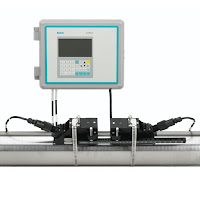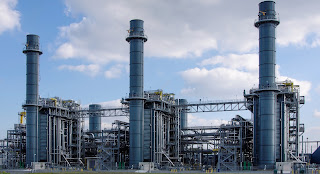 |
Ultrasonic Clamp-On Flowmeter
(courtesy of Siemens) |
A suburban township buys their drinking water from a major municipal water district. The township’s water distribution system network has four connections to the larger municipality’s water transmission main. The municipality has many customers and has implemented contracts with each of its wholesale customers that limit the peak flows and the time of day in which they may occur. If the wholesale customer exceeds the limit, they are assessed significant surcharges.
Because of the potential surcharges, the wholesale customers can financially justify investing in solutions to better control their water demand, minimize the usage peaks, and control what time of day they occur. These measures include elevated water storage towers, as well as control valves at each of the connections to the municipal provider’s transmission main.
Challenge The major municipal water district owns and operates “metering pits” with magmeters immediately upstream of the control vaults owned by each customer. However, as a rule, the signals from these meters are not made available to the any wholesale customers on a real time basis. Wholesale water customers are only given datalog summary reports from these meters on a routine schedule for billing purposes.
Without a method of measuring flows or getting flowrate data from the water district in advance, the township customer had no means of knowing, in real-time, the amount of flow they drew from the transmission main. Therefore, they did not know if or when they were exceeding the contractual peak flowrate limits and incurring significant surcharges from the water district until they were billed.
The township customer needs to know the flowrate at each of its four connections to the transmission main so they may control how much is being drawn at each site. They also need the total flow from the municipality’s transmission main, so they do not exceed their contractual peak demand.
The control vaults were initially installed without flowmeters. The intention was to use control valve position and upstream/ downstream (differential) pressure readings to estimate the flow through the control valve using the characteristic curve of the valve. This proved to be too complicated and cumbersome for their SCADA system to effectively implement.
Solution The local
Siemens representative worked with the township and their engineer to find a solution to measure the flow rate and totalize the volume of flow at each of the customer’s control vault sites. The most significant challenge was the piping configuration. All of the vaults were previously constructed without provisions for a flowmeter. The control valve vaults are very tight. The Siemens representative used a Siemens ultrasonic clamp-on flowmeter demo kit to demonstrate the technology to the customer, and prove that it would reliably meet their objectives. The vault with the worst piping configuration was selected for the demonstration. That would demonstrate that if the flowmeter would work in the worst site, it would work at the other three sites as well. However, if the Siemens flowmeter didn’t work in that site, the township would need to look at alternate, more costly, flow measurement technology for a solution. Within minutes of arriving on site, the unit was installed and providing reliable readings. The unit was allowed to log for a period of three days. After that, it was retrieved and compared to the readings from a competitive magmeter in the municipal water provider’s metering pit.
The logger on the Siemens clamp-on flowmeter provides helpful information on the quality of the velocity and flow measurements. This logged information helped establish and solidify the confidence of the owner and the engineer that the Siemens clamp-on meter would work for these applications.
Four key reasons the customer chose Siemens flowmeters:
- The Siemens clamp-on flowmeter has the capability to make the tough measurements and provide information on the quality of those measurements.
- The attentive, professional and knowledgeable service they received from the local Siemens representative was well supported by Siemens personnel.
- The local representative provided the field service to install the transducers on the pipe, and commission the transmitters.
- The local representative conducted the demonstration and assisted the township engineer with their evaluation of the ultrasonic clamp-on flowmeter vs. magmeters owned by the water district. The major water district supported the Siemens ultrasonic clamp-on technology used by the township customer after they attended a Siemens Level & Flow Seminar held in their district.
Benefits 
- Cost Savings - If they were not able to use the Siemens ultrasonic clamp-on flowmeters, the customer would have had to excavate and install a below-grade vault to house a magmeter and associated isolation and by-pass valves, along with conduit and wiring, at each of these four sites. This would have required cutting the water pipe and then going through a cumbersome disinfection process, both of which would have required lengthy permitting and costly testing. Further, some of the sites really had little or no room to accommodate such a structure or piping modifications. It is estimated these modifications would have totaled over $250,000. In comparison, the customer ended up spending $25,000 for the meters, and field service to install some conduit from the pipe to an existing above grade SCADA panel.
- Time Savings - The customer had already made improvements to the distribution system and installed four new control vaults. Their construction contracts were closing and they could not use their water tower until the new flow controls were added. Time was a critical factor. The customer saved 3-6 months in time by using the Siemens clamp-on flowmeters instead of having to construct new vaults to house magmeters.
- Improved Process Reliability - Now that the meters are in place, the customer can control how much water they are taking from the water district at each of these four locations, and ensure they do not exceed their contractual peak. They can now also properly manage the fill and draw of their elevated storage tank to offset peak demands, and fill/store during periods of low demand.








